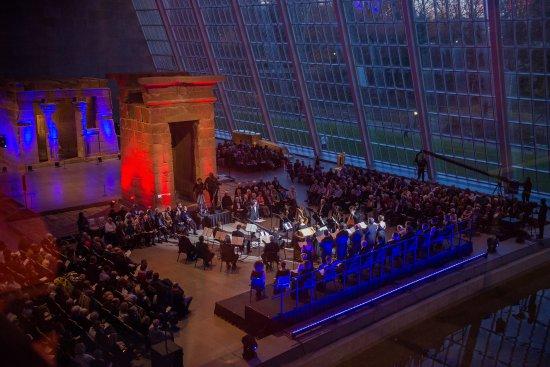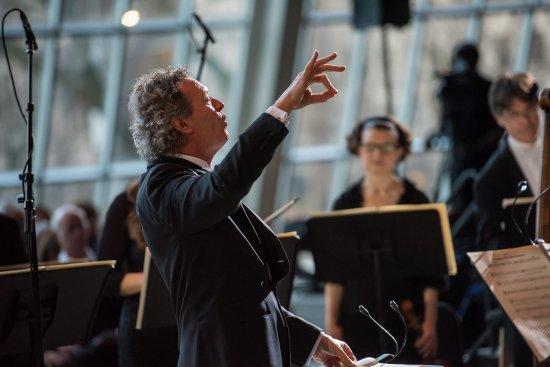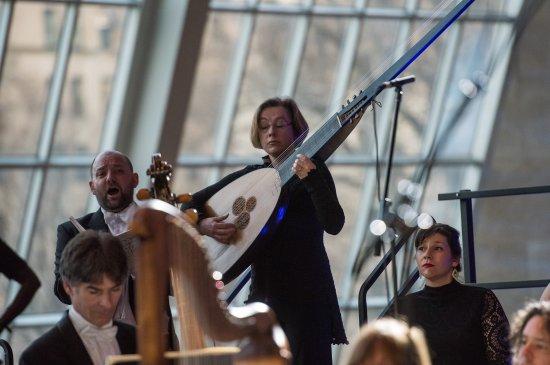Vespers of 1610 (Handel + Haydn Society Orchestra and Chorus)
A ravishing, splendid performance of a Baroque masterpiece in a setting of ancient Mediterranean architecture.

Handel + Haydn Society Orchestra and Chorus in Monteverdi’s Vespers of 1610 at the Metropolitan Museum of Art (April 8, 2017)(Photo credit: Stephanie Berger)
[avatar user=”Jean Ballard Terepka” size=”96″ align=”left” ] Jean Ballard Terepka, Music Critic[/avatar]A Baroque Venetian masterpiece of sacred choral music … an orchestra-and-chorus at the appropriately prestigious top of their game … an ancient Egyptian temple from the Roman Empire transported into a marvel of modern New York City architecture … what might this all amount to? In the case of the Handel + Haydn Society Orchestra and Chorus’s recent presentation of Monteverdi’s Vespers of 1610 at the Temple of Dendur at the Metropolitan Museum of Art: an evening of dazzlingly beautiful and moving music.
But one wonders what Monteverdi would have made of it. He would have recognized the music he wrote and appreciated the artistry of the musicians who presented it; he would have been grateful for the obviously passionate affection that the conductor lavished on each individual movement of the monumental work. But how would he have assessed the actual sound?
The acoustics of the museum’s huge Sackler Wing glass-and-stone containment space for the abstracted Dendur temple-essence are unlike anything that Monteverdi would ever have heard. That vast slanted glass separation of the temple from the green swaths of Central Park treats musical sounds – voice and instruments – in ways that the Basilica of St. Mark in Venice never would: the sound is simultaneously and contradictorily both brighter and more blurred. The organic, delicate feel of the Handel + Haydn Orchestra’s period instruments – earthy, breathy and tinkly all at once – is distorted and exaggerated, much as grass blades’ veins look impossibly sturdy under the lens of a dew-drop.
As a result, the great choruses of the Vespers – the psalm based Laudete pueri, Nisi Dominus, Lauda Jerusalem, and the choral components of the Magnificat – were sensuous, lush washes of sound, more Romantic than Counter-Reformation. It was a ravishing sound … perhaps not one that worshippers at St. Mark’s ever heard, but gorgeous nonetheless.

Conductor Harry Christophers and the Handel + Haydn Society Orchestra and Chorus in Monteverdi’s Vespers of 1610 at the Metropolitan Museum of Art (April 8,2017)(Photo credit: Stephanie Berger)
The placement of the singers was sometimes problematic. When soloists sang, as they sometimes did, from the risers behind the orchestra with the rest of the chorus, they were frustratingly hard to hear clearly: soft, long vowels came out well, as (unexpectedly) did trills and ornaments, but consonants were swallowed up by the space. As a result, in both big choruses and some solos, the texts were hard to understand; this difficulty was disappointing, especially because the Handel + Haydn singers are normally so reliable in their effective enunciation.
However, Harry Christophers, Handel + Haydn’s conductor, did move soloists around in the Dendur performance space, a procedure that may have had artistic purposes related to the text which had some happy acoustic effects.
For instance, sopranos Margot Rood and Sonja DuToit Tengblad came forward to stand close to Christophers himself in front of the free-standing temple “gate” for their ravishing Pulchra es duet. Every word, now, was audible; the singers’ wonderfully matched voices embodied a wealth of feminine responses to the experience of passionate love. The last two lines, “Averte tuos oculos a me, quia ipsi me avolare fecerunt,” were a thrilling unveiling of abandon to desire’s completion.
In the Sonata sopra Sanct Maria, women of the chorus moved temporarily from the risers to behind the gate; later in the Vespers, the tenor soloists, Jeremy Budd and Mark Dobell, also moved to that space. The effect was dreamily splendid: it was simultaneously a modern stereo surround-sound and an evocation of St. Mark’s multiple choir lofts.

Chitarrone player Elizabeth Kenny in Handel + Haydn Society Orchestra and Chorus in Monteverdi’s Vespers of 1610 at the Metropolitan Museum of Art (April 8, 2017)(Photo credit: Stephanie Berger)
The orchestra was in fine form. Individual performers were especially fine: chitarrone player Elizabeth Kenny was wonderful, in spite of the acoustic challenges particular to her instrument. Violinists Aisslinn Nosky and Christina Day Martinson shone throughout, and in their extended dance-duet, were brilliant.
Monteverdi’s writing for instrumentalists and singers alike could not possibly have been more demanding: he wanted them to show off so that he could as well. Under Christophers’ encouraging, disciplined hand, all the members of the Handel + Haydn orchestra and chorus are more than up to the task.
Vespers of 1610 is a big and oddly sprawling work. It makes no liturgical sense, and, in terms of texts, has little programmatic unity beyond a consistent Marian devotion. But it is a coherent whole of musical and spiritual experience. It gives the impression of limitlessness, as though there were no end to what Monteverdi could have kept on telling us, precisely because the sacredness and meaning of God’s sacred words are infinite.
Christophers and the ancient temple gave us a wonderful 1610 Vespers. It was an evening of transported experiences: in a place of ancient Mediterranean architecture relocated to a modern North American city, a seventeenth century piece of sacred music came to life in a radiant twenty-first century sound.
Handel + Haydn Society Orchestra and Chorus: Monteverdi Vespers of 1610 (April 8, 2017)
Metropolitan Museum of Art
Temple of Dendur, Sackler Wing, 1000 Fifth Avenue, in Manhattan
For more information: visit http://www.handelandhaydn.org or http://www.metmuseum.org
Running time: 75 minutes without an intermission






At last somenody who says that the acoustics of the Temple of Denfur are absolutely inappropriate for concerts, but the Met for some obscure and incomprehensible reason goes on using it for that kind of events.